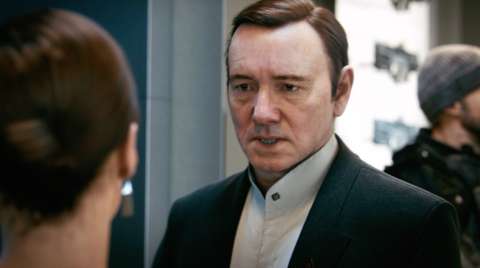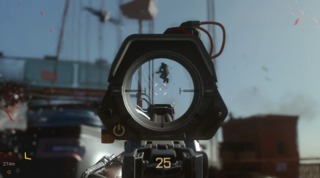By the time I finished Call of Duty: Advanced Warfare's single-player mode, I wanted to return to Seoul, South Korea, the setting of the game's first chapter. This mid-21st-century metropolis is awash in ultra modernity, to a degree I haven’t seen since visiting the economically prosperous version of Tokyo in the 1980s. It's the perfect futuristic backdrop to introduce Advance Warfare's new movement abilities, which are granted by the soldier-enhancing exosuit introduced in the campaign. And when you first bear witness to a flying giant snake made up purely of small drones roaming the streets of Seoul, you know this is new science-fictional territory for Call of Duty.
Sledgehammer Games crafted an opening that does everything a great first chapter is meant to do: it welcomes you with big-budget bravado, offers control tips without excessive hand-holding, and establishes the tone of the campaign. “Welcome back to Call of Duty,” the first chapter seems to say. “Let's show the other games how to make a proper entrance. And while we're at it, let's test your subwoofer with the bass of an explosion and the vibrations of slow-motion melodrama.” This is an introduction that kicks off the wartime journey of protagonist Jack Mitchell, played by Troy Baker. He begins as a U.S. Marine, but after a catastrophic event during his first mission, he joins Atlas, a private military corporation run by the generically named Jonathan Irons, who is played by a realistically-rendered Kevin Spacey.
It's never been easier for a Call of Duty campaign to justify the series' traditional chapter-by-chapter globetrotting. When the services of the Atlas Corporation are sold to the highest bidder, every country is fair game. That said, Mitchell's story isn't as clear-cut as it seems; he isn’t simply a Marine-turned-mercenary who travels where Irons tells him to. His tours offer a smattering of memorable missions, including a fast-paced intra-city manhunt through Santorini and several pulse-quickening escape sequences. Even Kevin Spacey’s boastful tour of an Atlas facility is a pleasurable golf-cart ride on rails that wouldn’t feel out of place as an EPCOT Center attraction, albeit one with a lot of killing machines in the background.
Aside from the positively imaginative two-chapter tutorial that kicks off the campaign, the one mission that leaves a lasting impression is a tense stealth op that prominently features a grappling hook. This tool is notably exclusive to the campaign, and when you discover its capabilities beyond traversing man-made structures, you can see why it was omitted from the multiplayer. The myriad locales work not only to minimize monotony, but also serve to showcase the talents of Sledgehammer’s art team in war-torn urbanity, dark forests, and sun-drenched deserts. Advanced Warfare's visuals come nowhere near the exquisite detail of the Metro Redux shooters; that would likely kill the game's 60 frames-per-second smoothness, which would be sacrilegious to the series.
Call of Duty games typically provide the chance to snuff out enemies from afar in their campaigns, but surprisingly, there is only one such sequence in Advanced Warfare. To be fair, though, enemy weapon drops are plentiful in scoped firearms, often with the same see-through-walls technology as one of the tech grenades. Sledgehammer’s future vision of weapon tech is positively practical with heads-up displays that are as clean as they are informative. The game varies the action in other ways, such as with a riveting sequence involving a jet ski with diving capabilities. (The campaign's other brief vehicular sections are unremarkable.) Certainly, I would have preferred more of these breaks from standard combat over the arduous occasions when you're asked to push objects. It is hardly a pleasure to shove an overturned van while having to endure the intentionally abrasive metal-on-pavement noise that accompanies it.



Advanced Warfare’s ties to the past are few. The only time you feel the weight of history is during the introductory chapter in Seoul: in a battle in which North Korea was invading South Korea in the mid-2050s, the 100th anniversary of the Korean Armistice Agreement is not lost in the chaos. Instead of looking back, Sledgehammer Games delivers a future-facing story laden with disappointing predictability and villain posturing befitting a Roger Moore-era James Bond film. Advanced Warfare serves so many classic bad guy one-liners that by the final act my eye-rolling gave way to resignation. I was left hoping that this Call of Duty had a point to its uncharacteristically cartoon-like dramatics, but it instead leaves you with an unsatisfying conclusion driven by a tonally inconsistent script. When the credits roll, you may be disappointed the villain didn't round off his checklist of cliches by uttering, “We're not so different, you and I.”
Whether intentional or not, the campaign is a narrative of echoes. If you've played your share of shooters from the last decade, you've seen these settings before. The passages of a naval ship echo the then-stupendous opening of Call of Duty 4, as does having a hardened British field mentor at your side for many of the chapters. Even if an obligatory bridge chapter reinforces the campaign's shortage of originality, at least these instances do not take away from the consistent entertainment of the overall playthrough. It follows the typical rhythm of a Call of Duty campaign, in which consecutive ground combat sections are broken up with a chase, a cutscene, or a quick time event.
Even though Advanced Warfare is set in the future, I’m glad Sledgehammer wasn’t compelled to show off nuclear-level devastation on the scale of Call of Duty: Ghosts' gratuitous opening. Nevertheless, Advanced Warfare stumbles when evocation gives way to shock with minimal exposition. This happens during a scene that's meant to echo World War II atrocities, depicting disturbing incidents of human experimentation. Without explanation or context, this scene only provokes for the sake of it, making any themes it raises tough subjects for meaningful discussion.
The majority of Advance Warfare's campaign gameplay adheres to Call of Duty's linear first-person shooter level progression, where combat boils down to suppression of the enemy near and far. There are also a handful of looser missions that hint at what a Call of Duty game might be if it aspired to the wide-linear designs of the two latest Crysis games. Those games excel by minimizing the frustration of death, where getting killed gives you the opportunity to try a new path or strategy with each respawn. Many of Advanced Warfare’s sections are spacious enough to experiment with new routes, and provide optional opportunities to use the exosuit. Yet therein lies one of the campaign's shortcomings: a lack of incentives to frequently use the exosuit. In the campaign, using these movement abilities is seldom mandatory, but always optional, and many environments allow plenty of room in which to play around. Nevertheless, the plethora of cover points will easily keep you alive, so why take a chance of being exposed, considering enemies aren’t especially aggressive? The boost dashes and double jumps are immensely useful to evade enemies; not so much if you want to take the fight to them. The ability to hover in single player is only useful for the few times you need to stick a landing from a multistory drop.
The thoroughness of the mobility-focused tutorial in the first chapter may lead you to think that the rest of the single-player mode would be rich in moments that encourage verticality, dodging, and temporary flight. Such events are only sprinkled through the game's 15 chapters, as there are too few sections in which using an exo ability is mandatory. The campaign is an entertaining ride as a whole, but being able to progress through most of it with a classic Call of Duty approach is wholly unfortunate, as it contradicts the expectations set by the futuristic motifs of the initial chapter in Seoul and that fantastical giant drone snake.
His tours offer a smattering of memorable missions, including a fast-paced intra-city manhunt through Santorini and several pulse-quickening escape sequences.
You can trust that bloodthirsty friends and strangers in multiplayer will make sure you know every movement ability, lest you desire a humbling kill/death ratio. You never forget your first death at the hands of an online opponent who outmaneuvered you with a midair strafe-double jump combo. The moment you witness such a move is the moment you want to learn it. The tired adage of "Easy to learn, hard to master" does not apply here; rather, it's “Moderately tough to learn, even tougher to master.” It's one thing to instantly see the benefits of a power slide or a double jump; it's another to apply these abilities in useful and practical ways. The lessons of First-Person Shooter Survival 101 and the economies of movement apply here: Just because you don't want to be killed while standing still doesn't mean you should be moving at all times.
The maps aren’t quite like the Call of Duty maps you’ve played before: the upward mobility provided by the exosuit calls for more vertical structures. Advance Warfare does a fine job in addressing issues with first-person platforming, letting you catch the edges of rooftops if your double jump wasn’t as long as you expected. That’s not to say that the maps completely cater to every new ability. As fun as it is to evade a hunter by sliding under a pickup truck, these multiplayer maps aren’t packed with such escape points. This kind of scarcity only makes wise use of the slide move all the more meaningful. Map memorization is thus all the more crucial, especially given how the maps in Advanced Warfare are understandably larger than typical Call of Duty maps.
With great abilities come expanded loadout options. The Pick 10 System that worked so well for Call of Duty: Black Ops II has expanded to 13 picks. This level of flexibility is tied to the one-size-fits-all-modes design philosophy of the 13 maps. Sledgehammer does not reconfigure arenas to suit a given game type; you are expected to adapt to each mode by having a custom loadout at the ready. A self-tailored speed-based loadout is crucial for the new point-based Uplink mode. This mode takes much of its inspiration from end-to-end goal-scoring sports like basketball and soccer, asking you to throw or dunk a device into an endpoint. Uplink is still primarily concerned with the shooting action, however, and thus defies categorization as a mere novelty mode. It’s also terribly absorbing.


For all the futuristic weapons technology at your disposal, there's comfort in having these firearms in multiplayer sorted into familiar categories. Like donning a new pair of shoes with zero break-in time, creating a comfortable loadout of fictional weapons suited for Team Deathmatch takes little brainwork. If you’re a Call of Duty veteran, don't be surprised if your initial loadout yields a satisfying kill/death ratio after your very first match. The only thing better than slotting a high damage IMR assault rifle in your loadout is seeing immediate results through your bodycount.
Progressing and obtaining rewards in Advanced Warfare's multiplayer is a layered experience, and Sledgehammer has erred on the side of excess. Beyond the straightforward rewards of actively participating in matches, the studio also recognizes the appeal of the blind box though its Supply Drop system. Considering that it would take tens upon tens of hours to unlock every possible Supply Drop item, it's a relief there's no risk of unlocking duplicate items. The one exception is if you convert an unwanted Supply Drop reward into experience, which is a practical option for some, but it opens up the possibility of unlocking that item again.
This abundance of content is also seen in the suite of multiplayer modes. Hardpoint, not seen since Call of Duty: Black Ops, makes a much welcome return since it serves as Advanced Warfare's King of the Hill mode. Due to their fundamental similarities, Uplink could have easily replaced Capture the Flag as the only delivery-style match. Instead, both are offered, as if Sledgehammer is saying, “Let's give the fans almost every mode imaginable and let them decide what will be the popular modes in six months’ time.” The finishing touch on this rich inventory of content is an acknowledgement to the Call of Duty purists: four classic modes (Team Deathmatch, Domination, Kill Confirmed, and Search and Destroy) that are played without exo movement. This works both as a throwback to familiar locomotion and as an experiment on how traditional matches would play out in maps larger than prior Call of Duty multiplayer maps. You won’t find anything as tiny as the ‘Hijacked’ yacht from Black Ops 2; some maps in Advanced Warfare can fit a boat three times that size.
In contrast to the map-altering catastrophes you can trigger in Call of Duty: Ghosts, Advanced Warfare's multiplayer shows restraint in dynamic map events. A tsunami warning in the San Francisco map will compel many first timers to hurriedly search for higher ground, only to realize the ensuing flood is a laughably minor and temporary one. Sledgehammer should also be commended for designing original multiplayer maps without borrowing heavily from the single-player locales. Equally impressive are the settings not featured in the campaign, including a volcano in Hawaii and a space elevator platform in the Gulf of Mexico. These maps are generally roomy, but hardly bereft of confining spaces and narrow hallways. In sector-control modes like Momentum and Hardpoint, the hallways in maps like Bio Lab and Greenband make for brutally crowded gunfights ripe for increasing both your kill and death counts. These battles would be frustrating were the chaos in the moment not so fun and hilarious.
Advanced Warfare foregoes the novelty of ghosts and zombies in its wave-based cooperative mode, dubbed Exo-Survival. It's just as well; when you have drones, double-jumping soldiers, and hulking armored suits swarming towards your foursome, are supernatural armed forces necessary? As if to boast the versatility of the 13 multiplayer maps, none of the locales have been altered to suit any specific needs for human-versus-bot combat. The maps are divided into four difficulty tiers, partly based on how the terrain of each setting helps or hurts your team. For example, the three points of entry in the hotel lobby of the Terrace map make this reception area an ideal home base. The challenge arrives when you must leave the comforts of the lobby during non-defensive missions. When you only have 90 seconds to collect 20 dog tags and a map that is as tall as it is wide, a team that splits up without pairing up is most likely a dead one. The map called Riot, on the other hand, has little to no spots in which to safely huddle for a defensive posture, so it's no surprise that it's the only Tier 4 map. If you're looking for a first-person recreation of the nerve-wracking “elevated position” scene from the film The Rock, play the Riot map in Exo-Survival.
Level complexity is a factor, and is one of the reasons why the modest two-story Bio-Lab map is classified as Tier 1. With many obvious bot entry points, Bio-Lab is a fitting starter map for Exo-Survival newcomers. Surviving a round yields currency to spend on upgrades, and it's not unusual to max out armor or weapon stats by the 30th round. The likelihood of passing 40 rounds on a first or second attempt brings about two classic yet unexpected opponents: complacency and overconfidence. You seldom see this issue in wave-based survival modes, where the progression of difficulty is often much steeper. Even in a Tier 1 map, ending a session should be the result of your team dying, not of your team getting bored and wanting to try try a harder tier. I would have preferred the option of elevating to a higher tier after clearing 40 or so rounds so my teammates could maintain their momentum without having to back out into the lobby.
The last time Call of Duty had “Warfare” in its subtitle, it led to a well-received trilogy that deftly transitioned the series away from a well-trodden global conflict to modern-day combat. If the settings of today have run their course just as World War II did years ago, Advanced Warfare makes for a convincing foundation of futuristic yet relatable combat that is worth exploring and expanding further. The huge change in player mobility is less of a paradigm shift and more of an overdue retooling for an 11-year-old FPS franchise, especially in a year of mobility-focused shooters. Yet for all its predictability, Advanced Warfare is a deluge of action-film bravado, and it's difficult to not be carried away by its tidal forces.